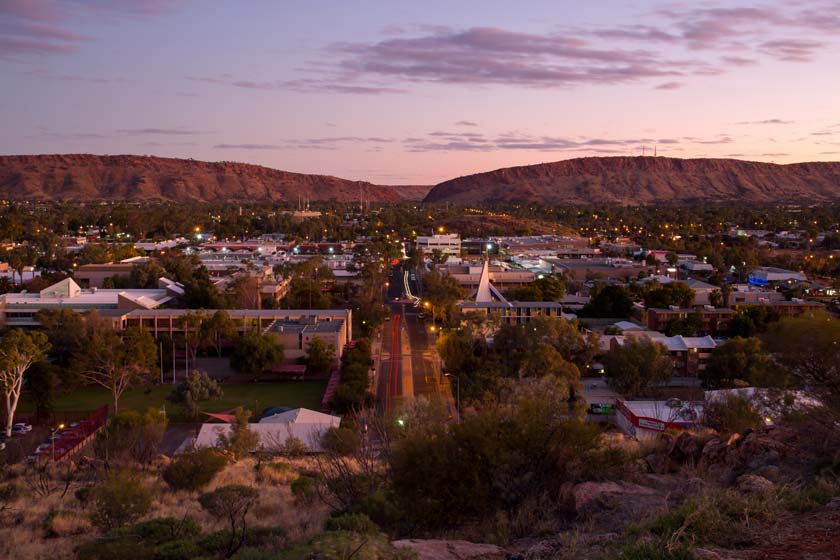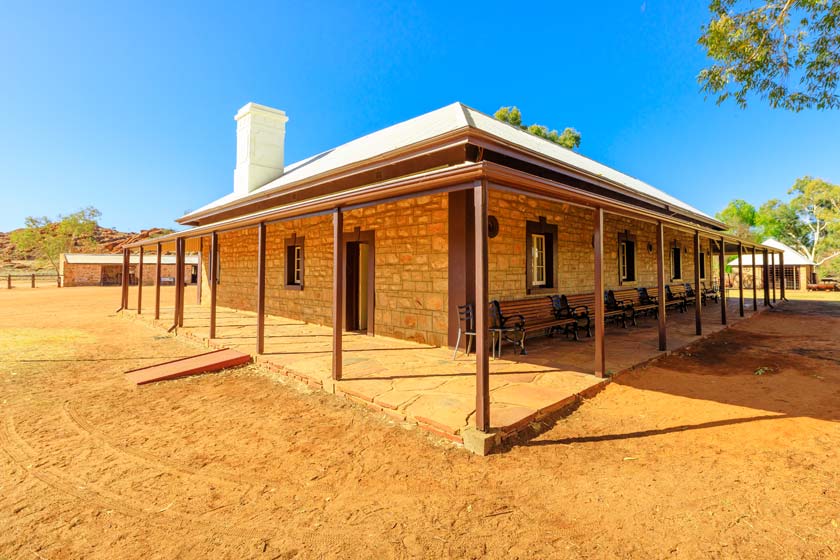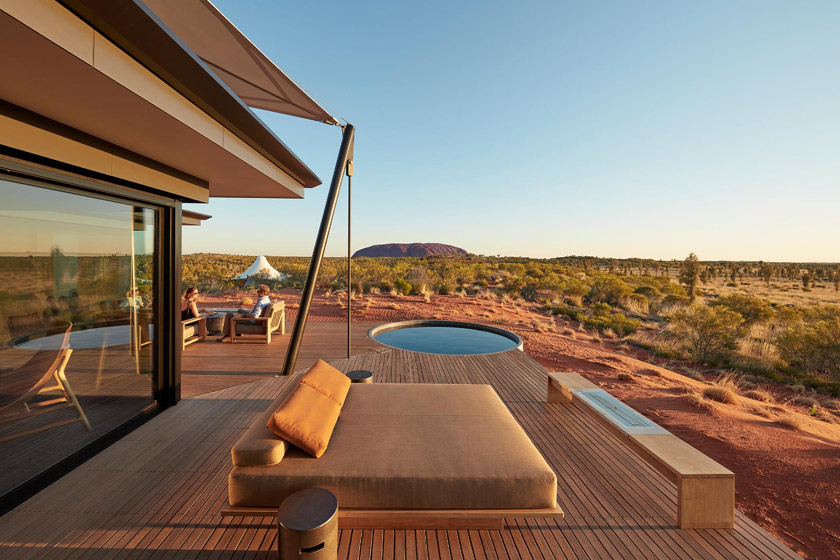Alice Springs & Surrounds, NT
Alice Springs is a must-see destination and an ideal jumping off point to explore central Australia. A visit to Yulara and the iconic Uluru-Kata Tjuta National Park, home of the monolith Uluru/Ayers Rock, situated 461 kilometres south west of Alice Springs is an unforgettable experience – see the short video below (duration 2:36).
A Town Like Alice
Set on the banks of the usually-dry Todd River, the modern town of Alice Springs is well equipped with a wide range of facilities, attractions and accommodation.
Travellers can enjoy the view from Anzac Hill, browse the Alice Springs Cultural Precinct, learn about the hardships of the pioneers at the Alice Springs Telegraph Station or the Royal Flying Doctor Service, meet rare and endangered wildlife at Alice Springs Desert Park or tee-off on one of the best desert golf courses in the world.
A range of quirky events also provide entertainment – cheer at the Camel Cup, see the hilarious ASSA ABLOY Henley-on-Todd (a ‘boat’ race on the dry Todd River), or road test one of 3000 beanies at the Alice Springs Beanie Festival.
The MacDonnell Ranges straddle the town, and the spectacular West MacDonnell National Park is home to many amazing natural attractions, such as Ellery Creek Big Hole, Trephina Gorge Nature Park, Simpsons Gap, the Ochre Pits and Standley Chasm.
Imagine a land where deep chasms and gorges carve though towering ranges, where the vast desert surrounds a palm-fringed oasis, where the culture of an ancient people and the vibrant character of the outback form a unique Central Australian story.
Hermannsburg
The Larapinta Trail, an exciting long distance walking track, runs for 223 kilometres through the West MacDonnell National Park from Alice Springs west to Mt Sonder. The Finke Gorge National Park, Hermannsburg (a historic Aboriginal settlement, and the birthplace of artist Albert Namatjira), Palm Valley and Ewaninga Rock Carvings Conservation Reserve are a short drive out of town.
Those looking to go further off the beaten track can explore the Simpson or Tanami Deserts, fossick for gems at Glen Helen or Ruby Gap, or visit remote communities like Santa Theresa and Titjikala, where tours offer a chance to experience Aboriginal culture. You can search for bush tucker, watch local artists create art and craft pieces, or simply sit in on a story-telling session. You can even go hot air ballooning from Alice Springs, and see the red centre from the air!
Find life in the desert
At first glance Australia’s desert, although cruelly beautiful, looks too harsh to support life. What a surprise to learn that it supports abundant wildlife! The Alice Springs Desert Park, a short bike-ride from the Alice Springs town centre, will acquaint you with all the desert’s wealth of life.
The park is set against the rust-hued backdrop of the MacDonnell Ranges and reveals desert secrets in a scenic walk and interpretive centre. It allows the visitor to learn about the different kinds of terrain, habitats and animal life that evolved over 4,500 million years to depend upon the desert.
A 1.6 kilometre path winds through three typical desert habitats – desert rivers, sand country and woodland – and introduces you to the little creatures that dwell in them. That’s around 120 species of animal and 350 species of plant! Little hopping mice, numbats, flitting birds, languid reptiles and quolls will captivate.
A special nocturnal display brings you face to face with the shy creatures that always eluded you before. A presentation of free-flying birds of prey gives people the first real insight into the lives of these magnificent birds, from smaller kites to majestic wedge-tailed eagles. You can also learn about how the Aboriginal people have managed the desert over thousands of years. With tour operators frequently going to the park it’s easy to access and spend a few hours there; real nature lovers make a day of it.
Here, under the rainbow
Rainbow Valley is another of those spectacularly beautiful spots in central Australia that seem designed especially for people who love looking at beautiful landscapes. Rainbow Valley, part of the James Range, is around 75 kilometres, or less than an hour’s drive from Alice Springs. The name comes from the array of colours in the stone, ochre, rose, vermilion, rust and gold. The colours seem to change according to different moods of atmosphere, light and time of day.
A combination of water, weathering and erosion has coloured and sculpted the semi-circle of peaks and valleys that make up this reserve. Over millions of years, the red iron of the sandstone layers was dissolved in water, and then drawn to the surface in the dry season. The red minerals formed a dark, iron-rich surface layer, with the white layers lying below. The dark red capping is hard, and weathers slowly while the soft white sandstone below weathers far more quickly, into loose sand.
Weathering and erosion has also sculpted the shape of the peaks and the valley into bluffs, peaks and towers.
The best time of the day to come here is sunrise or sunset, when the light really has a chance to transform the peaks. Visitors are welcome all year around, to go camping, to bushwalk and to take fantastic pictures. However the best time to come is during the cooler months, between April and November.
Ideal touring base
Few visitors to Uluru return unchanged. It’s easy to see why the rock and the surrounding land has such huge spiritual significance for the Anangu Aboriginal people. It lies in Australia’s red centre like an enormous, moody heart.
Uluru is 9.3 kilometres in circumference, and the icy-green and grey vegetation at its massive feet offer a refuge for wildlife. It is immense in size – yet more than two thirds of the rock is actually hidden beneath the ground. Then there’s its sheer beauty: it outshines even the brilliant sunset, arraying itself in a multiplicity of hues from black to purple, blue to brown, orange and red throughout various times of day and weather. It makes a spectacular contrast with the relatively flat sand plain that surrounds it.
Uluru’s cousins, the Olgas, or Kata Tjuta, make another sacred site just 32 kilometres away: a collection of 36 steep, rounded, russet domes over around 3,500 hectares.
Both these splendours are encompassed by Uluru-Kata Tjuta National Park. At its entrance you can find all sorts of accommodation for your voyage of discovery, from campsites to luxury resort stays. Then there are so many ways to encounter the land around Uluru. A hike up the rock, or a campfire dinner, where you can savour barramundi, emu or kangaroo underneath an incomparable starlit sky. Drink in the sunset while you sip champagne, or encounter the landscape on a Harley Davidson. Or see it from a grand height -Â either a light plane or a camel’s back!
Plenty to do in Alice
The School of the Air is located at 80 Head Street, Alice Springs. Learn how this unique school, with a broadcast area of 1.3 million square kilometres, serves the needs of isolated children living in the outback.
Touring the school, you will share in the experience of one of the most unique educational facilities in the world. The school provides daily lessons by HF Radio to isolated children living on cattle stations and Aboriginal communities, in road houses and national parks.
Visit the Royal Flying Doctor Service to see first-hand how outback Australia benefits from the medical assistance provided by the RFDS. Uniquely Australian, the RFDS story is forever linked with that of its founder, the Very Reverend John Flynn – a story of achievement that gave courage to the pioneers of the inland. At the RFDS Visitor Centre you can learn about the history of the service, and how it maintains its vast network today.
Nestled against a backdrop of the spectacular MacDonnell Ranges, just 10 minutes drive from the centre of Alice Springs, the Alice Springs Desert Park showcases the landscapes, animals and plants of Australia’s deserts and their traditional use and management by Aboriginal people.
Welcoming outback city
The urban heart of central Australia is Alice Springs, a free-spirited, sunbaked, open-skied city that never fails to charm. Sitting between the east and west MacDonnell Ranges, Alice is a paradise of slender white gums and grey-green foliage, against rose-hued earth and hills underneath a dazzling blue sky. The locals are the friendliest you’ll find – chat to them and you’ll discover that many were once just visitors who fell in love with the town and could not leave. And why not? The climate is warm, the air is pure and the pace is relaxed.
It’s a neat little city of around 30,000 people, born in 1862 with the creation of an overland telegraph line. The arrival of The Ghan railway in1929 kicked Alice Springs forward into development and prosperity. Cattle stations spread outwards from the town as settlement expanded and gold was discovered. Now it is a town that you can visit either on your way to the red centre’s outback icons, or to enjoy just by itself.
In and around the city centre the Arrernte people share insights into their culture. And right outside the city, the Alice Springs Desert Park brings you face to face with the mysteries of the desert communities, rare plant life, scurrying native fauna and free-flying birds of prey. Adventure is never far off. Some 18 kilometres out of town is Simpson’s Gap, a walk through rocky gaps and steep ridges, and tours frequently leave for other wonders such as Kata Tjuta (the Olgas), Uluru, Kings Canyon, Finke Gorge, Ormiston Gorge and Pound and Rainbow Valley.
Website: www.uluru-australia.com
Where to stay?
Alice Springs & Surrounds Destinations
Experiences
- Caravan and Camping
- Farm/Station
- Rural/Country
- Cultural
- Environmental
- Food and Wine
- Historic/Heritage
- Nature based
- Remote
Popular Activities
- Off Road Driving
- Ballooning
- Mountain Biking
- Bush Walking
- Canoeing
- Rock Climbing
- Cycling
- Driving
- Golfing
- Scenic Flight
- Shopping
- Sightseeing
- Skydiving
- Swimming
- National Park
- Winery
- Wildlife
- Outback
- Quad Bike Riding
About Alice Springs & Surrounds
- Locality: Major urban locality
- Alice Springs & Surrounds Postcode: 870
- State: Northern Territory
- Region: Alice Springs & Surrounds
- Latitude: -23.70036
- Longitude: 133.88089
- Elevation: 581m
- Population: 300
- Median Income: $41340
- Area (Sq/km): 1.394
- Timezone: Australia/Darwin




